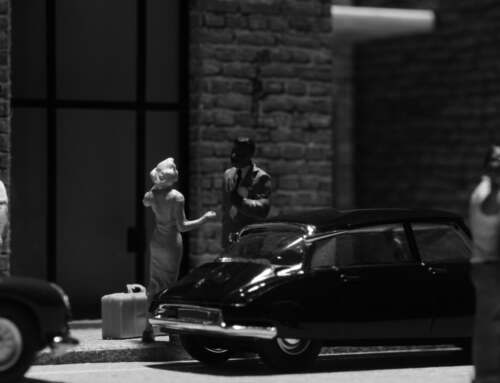In this series on The Basics I’ve already touched on Leading Lines and Foreground Interest, two methods that help you create a visually interesting image . Another classic method you can use to balance and organize the visual elements in your photographs is The Rule of Thirds and its compositional cousins The Golden Ratio and the Phi Grid.
Before I go any further I want to stress that these concepts are guidelines, not rules. Once you have learned the basics of composition, any rule can, and sometimes should, be broken.
The Rule of Thirds requires you to imagine a grid over your image that consists of two horizontal and two vertical lines. If you line up the important elements of your image along these lines or at their intersections, you can create a nicely balanced and more interesting image than by simply placing your subject in the center of your composition.

The easiest of the organizing methods to use is the Rule of Thirds. In many ways, this is a simplified version of the Phi Grid and the Golden Ratio.
These imaginary lines are not hard and fast rules, but a guide to help you think about your composition and where you want to place the important elements. For example a strong horizon line will look more natural if placed either 1/3 of the way down from the top of the frame or 1/3 of the way up from the bottom of the frame rather than placed directly in the middle. If you line up your subject with one of the horizontal / vertical lines or one of the four intersections you will create an image that has a visually pleasing and balanced composition rather than centering your figure in the middle of the frame.
It’s easy for small subjects, like toys, to get overwhelmed by their environments. By placing them off center and opening up the composition you give your subject space and it will become the natural focal point of your scene. Also by increasing the negative space (empty areas) around your subject you’re creating opportunities for even more creativity. The negative space is a great opportunity to utilize other compositional tricks like foreground interest, leading lines, texture, light and shadow to bring more structure to your image.
The Golden Ratio is similar to the Rule of Thirds although it’s based on the mathematics of Leonardo Fibonacci rather than design theory. While the Rule of Thirds divides the picture frame into nine equal cells, the Golden Ratio divides the frame using a fibonacci spiral. The spiral is a great guide to use if you have strong curves leading to your subject or you want to use the diagonal lines created as your focal points.

Diagonal lines emanating from the center of the fibonacci spiral can be used to add structure to your composition.
The Phi Grid is similar to the Rule of Thirds grid, but is divided using the ratio of 1:1.618. In fact many photographers simply view the Rule of Thirds as a simplified Phi Grid (see diagram below). But I don’t think its that simple. Below is an image that shows how the Phi Grid relates to the Golden Ratio. Don’t you love math!

A handy illustration that shows the differences between a standard Rule of Thirds grid and the Phi Grid.

The Phi Grid (in black) illustrates how it can be used in conjunction with strong diagonal lines (in blue) to create strong focal points at the intersections.

I really like this illustration and how it shows the relationship between the Fibonacci Swirl / Golden Raton and the Phi Grid.
None of these guidelines are better than the other, they’re simply an easy way for you to start thinking about the composition of your image. If you’re not used to thinking about your images in this way it might feel a little overwhelming and confusing. But with a little practice, you will be composing your images with one of these methods with not a lot of extra thought.
Whenever I get behind the camera and start to frame my image I always try to view the scene through the lens of Rule of Thirds or the Phi Grid. I like to think I can visualize the Golden Ration, but who the heck am I fooling! When I’m editing in PhotoShop I often pull up the Fibonacci Spiral to see if it will work with my image just for fun.
Like I said before these cropping overlays are guidelines, not hard and fast rules. It doesn’t matter what method you use for any given photograph as long as you know the rules, are prepared to break them and as always create your photograph with intention.
Now go out and practice!
~ xxSJC
I’ve included a few sample images that use one of these methods. Can you tell which one I used? Do you think it matters?
Of the three methods I’ve mentioned do you have a favorite and if so, why?
There are so many different ways you can mathematically and graphically organize your images. If you’re interested in seeing a complete array of cropping overlays for your photographs please check this out.

















Fascinating post Shelly! I had no idea there were other guidelines besides the Rule of Thirds. The Golden Ratio sounds very interesting, I’ll have to look into it further. I’m always interested in anything that uses mathematics 🙂
I’m really enjoying this series. I’ve learned so many useful tips already 🙂 Thank you for writing these posts!
Thank you Lynn of your comment! Even I learned a few tricks from this one. I had no idea there were “golden triangles” bad on the Golden Mean. I think geometry and mathematics is a fascinating way to look at composition. When I use the cropping guides in PS I know they work, my photos always look better when I crop with intention. Now I have to move towards doing this better ‘in camera’ so I can retain my pixel count. 🙂